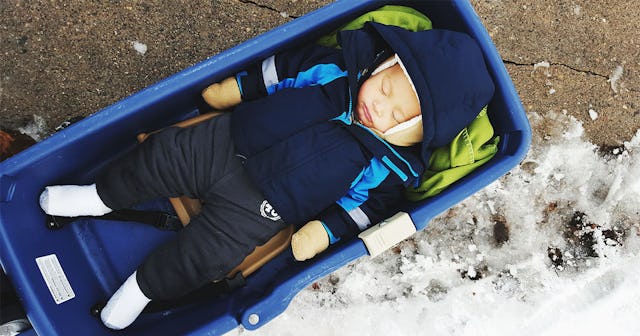Why Scandinavian Babies Nap Outside In Cold Weather

Want a swift and brutal visit by Child Protective Services? Let your baby nap outside in cold weather. It happened to Danish actress Anette Sørensen in 1997, reports the BBC, on a chilly day in May when she and her husband left their 14th month-old outside a New York City restaurant while they had drinks inside. They repeatedly checked on the baby. Patrons still called police, and they were arrested on child endangerment charges. Social services briefly took their child. Of course, patrons called because the child was left alone. But they also likely called because of the weather.
Except letting babies nap outside in cold weather is a cultural practice in Scandinavia — sometimes when they’re as young as two days, but more often at about two weeks, says Linda McGurk, author of There’s No Such Thing As Bad Weather, on Rain or Shine Mama. And no, you don’t have your geography wrong. In Scandinavia, outdoor temperatures regularly drop below freezing, and parents stick their babies out there in cold as low as five degrees Fahrenheit. Some go as low as –16 degrees F.
Dude, I don’t go outside at those temperature. I hygge myself up in my house and pray the weather changes. But the babies? The babies nap outside in weather I’d consider frigid and miserable. In fact, people often consider 21 degrees F the ideal napping temperature.
Okay. WTF? Babies and cold don’t mix. Except they do. The BBC says even preschools make babies nap outside, with one preschool outside Stockholm sticking the wee ones outside in their strollers until age three. The head teacher Brittmarie Carlzon says, “When the temperature drops to -15C (5F) we always cover the prams with blankets … It’s not only the temperature that matters, it’s also how cold it feels. Some days it can be -15C but it actually feels like -20C (-4F) because of the wind.” On those days below -4F, they bring the kids inside.
Why let babies nap outside?
Sebastian Condrea/Getty
The Scandinavians cite many reasons to have babies nap outside. McGurk refers to the concept of friluftsliv, which basically translates to “spending time outdoors to get a change of scenery and experience nature with no pressure to compete or achieve.” It’s the idea that “returning to nature is coming home”: learning about nature, increasing your self-esteem through experiencing it, “rediscovering our natural, biological rhythms through immersion in it,” and cultivating a deep, abiding sense of love and reverence for it. When Scandinavian parents let their children nap outdoors, they start that concept of friluftsliv at a very early age.
Here’s how: McGurk says that the sounds of nature themselves are “soothing.” How many of us run white noise machines that include chirping birds, rushing water, and wind in the trees? One study she cites says that these sounds decrease the body’s fight-or-flight response and make it easier to relax — hence promoting better sleep. The study was done in adults. But it could be applicable to children, too.
Because Scandinavian parents claim that their babies nap better outside.
They also claim that babies get sick less often when they’re exposed to the outdoors instead of cramped in a preschool room with 30 other children. There, germs run around and around; any mom of a preschooler knows that if one kid comes down with something, soon the whole class will be knocked out. But McGurk says on Rain or Shine Mama that studies have proven kids who go to forest schools, where they spend most of the day outside, take fewer sick days than kids in traditional schools.
But the BBC says the Swedish Environmental Protection Agency has found mixed results. Toddlers who spent more time outside took fewer sick days — not just when they were napping outside. But, they say, “In other studies there wasn’t a difference.” So the scientific evidence for letting babies nap outside? Mixed, but it seems like common sense for many parents when compared with a germy preschool.
How to do it?
Dmitrii Guldin/Getty
McGurk goes into explicit detail about how to let babies nap outside. They should sleep in a pram or reclining seat (for older toddlers) and need a wool underlayer. On top of that, one puts a snow suit with built-in mittens, a hat, and a bunting bag. The BBC reports that the Scandinavians have a saying: “There is no cold weather, only bad clothing.”
There are also some safety issues. Of course, make sure you can always see your baby’s face, and there’s no way for them to turn their head and suffocate: they should be swaddled up well (one of the other reasons Scandinavians suggest, according to the BBC, that babies nap outside so well).
Check your baby often: feel their chest, which gives you the best indication of their body temperature. Make sure their hands don’t get too cold, and neither do their tiny baby noses. You may want to use a baby monitor. And make sure animals can’t get in to bother the baby (I’m picturing marauding squirrels, but this is serious).
If you aren’t afraid of a call from social services, letting your baby nap outside seems like a great cultural practice. Alas, the culture of American parenting is against us, and making babies nap outside merits something akin to child abuse. Not only could they get too cold — there’s stranger danger to worry about! Marauding crows! Imagine it, and so could that nosy neighbor.
It’s an option. But letting babies nap outside may be a cultural step we Americans aren’t quite ready for.
This article was originally published on